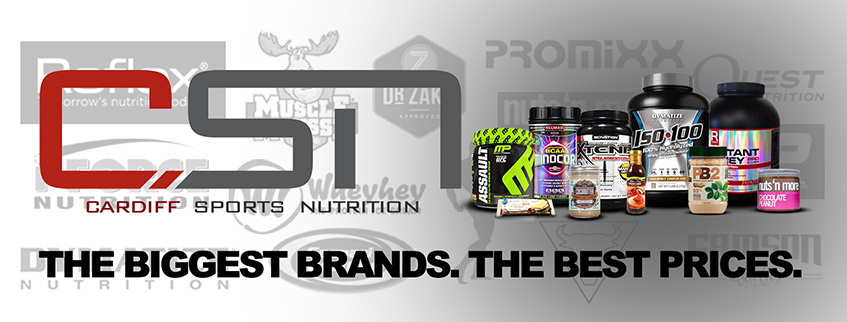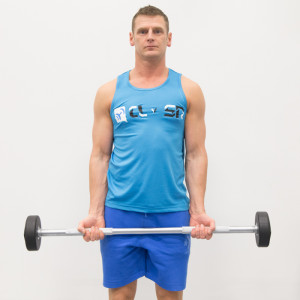Barbell Drag Curl
Starting position:
- Grasp the bar with a closed, supinated grip (the back of your palms facing the front of your thighs).
- Extend elbows, resting the bar or barbell on the front of thigh.
- Stand straight with feet shoulder width apart, keeping a slight bend in the knees.
- Keep upper arms tucked against torso and perpendicular to the floor.
Upward movement/concentric phase:
- Begin to flex elbows while shifting your arms and elbows back.
- Slide the barbell up your abdomen as high as you can as your elbows flex. The bar should reach just below pectoral muscles.
- Keep standing up straight and keeping arms tucked in at sides.
Downward movement/eccentric phase:
- In a controlled fashion, allow the elbows to extend back to the starting position moving the barbell down the abdomen.
- Keep standing straight and keeping arms tucked in.
- As you return to the barbell to starting position allow arms and elbows to return forward.
Exercise Data
FAQ'S & FACTS ABOUT Barbell Drag Curl
What Is A Biceps Barbell Drag Curl?
The drag curl is a variation of the standing biceps curl. It is a resistance exercise, which involves the primary elbow flexors, the brachialis and biceps brachii. It also involves the primary forearm flexors, the flexor carpi radialis and flexor carpi ulnaris. Compared to other biceps exercises, the drag curl involves a shorter range of motion since the shoulder is in a position of extension (the arms and elbows are moved back) as elbow flexion occurs.
As the arms begin to shift back, the long head of the biceps brachii is activated. Placing tension on the long head of the biceps brachii complements overall hypertrophy of the biceps and helps to develop the “peak” of the muscle.
This exercise can be performed with an Olympic bar or other barbell alternative. The concentric portion of the lift is elbow flexion, which involves the lifting of the weight. The eccentric portion is elbow extension, which involves the descent of the weight.
The purpose of the drag curl is to stress the biceps from a different angle while also activating forearm muscles. This exercise strengthens the biceps while promoting hypertrophy (increases in size) of the biceps and forearms.
Why Do A Biceps Barbell Drag Curl
Drag curls strengthen and increase the size of the biceps brachii, brachialis, brachioradialis and major forearm flexors. Although it is primarily an exercise for aesthetics, drag curls also serve as an auxiliary exercise that can increase strength involved in other multi-joint exercises.
Anatomy Of A Biceps Barbell Drag Curl
The biceps brachii is located on the front of the arm, originating at the shoulder and inserting in the elbow joint. It consists of two heads, the long head (outer biceps) and the short head (inner biceps). The long head tendon helps stabilize the shoulder joint and its origin is located at the tubercle and lip of the glenoid cavity of the scapula (shoulder blade). The short head origin is located at the coracoid process of the scapula. The long and short head unite as the muscle bellies run down the front of the arm. Both heads merge, sharing insertion into the radial tuberosity of the elbow joint.
The biceps brachii flexes the elbow joint and supinates the forearm. Supination refers to the simultaneous rotation of the wrist and elbow as the palm of your hand faces upward.
The brachialis lies underneath the biceps brachii, originating at the front of the lower end of the humerus bone. Its insertion is located at the coronoid process of the ulna at the elbow joint. The brachialis is a primary elbow flexor.
The brachioradialis aids the biceps brachii and brachialis, helping stabilize the elbow joint during biceps curls.
Although their contribution is minimal, forearm muscles, palmaris longus, flexor carpi radialis, and pronator teres contribute as weak flexors of the elbow joint.
As the barbell slides up against the body, tension on the forearm flexors, flexor capri radialis and flexor carpi ulnaris, increases.
Variations Of A Biceps Barbell Drag Curl
Wide grip, EZ bar.
How To Improve Your Biceps Barbell Drag Curl
Strategically varying your grip width can result in optimal muscle activation that increases strength and hypertrophy of the biceps and forearms.
Emphasis on eccentric contractions, prolonging the eccentric portion of the contraction, may also be incorporated in a training program focused on increasing strength. This should be implemented accordingly and with adequate muscle recovery as eccentric contractions cause substantial damage to muscle tissue.
It’s important to note that your repetition and set volume will depend on your goals (e.g. strength, hypertrophy, muscular endurance). It is also important to allow adequate recovery days in between biceps and forearm training to allow muscles to repair.
Common Mistakes When Doing Biceps Barbell Drag Curls
It is very common to observe an individual swinging their torso in efforts of lifting the weight with more ease. This compromises proper technique and biceps contraction. It is imperative that the torso remains straight for optimal execution of a drag curl.
Standing on an unstable surface or with an unstable stance can also compromise technique. Your feet are your foundation and should be in a position of stability. If you are looking to maximize the contraction of your biceps, ensure that your feet are shoulder width apart with a slight bend in the knees. Stand on a flat surface. Standing with one foot in front of the other during a standing biceps curl can also compromise balance and decrease the potential for optimal muscle contraction.
Injuries Or Ailments & Their Effects Regarding Biceps Barbell Drag Curls
If proper technique is not adhered to (e.g. swinging of the torso, dropping the weight quickly instead of controlling the descent on the eccentric portion of the lift), the likelihood of back and/or biceps injury increases.
Although rare, biceps tendon rupture may occur if warm-up is not sufficient and/or if intensity (load) is increased inappropriately.
If proper recovery is not implemented between training days for optimal muscle repair of the biceps, the biceps tendon becomes inflamed. Without proper rest and treatment, the inflammation remains and results in biceps tendonitis.
Impingement syndrome and rotator cuff injuries, in general, are commonly associated with biceps tendonitis/biceps tendinosis. Therefore, it’s best to avoid bicep exercises when addressing impingement syndrome/rotator cuff injury unless advised by a physical therapist.





